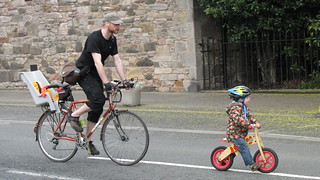Things that sprung to mind this morning....
.one
There does appear to be noticeable drag on the dynohub when I switch the lights on, why is this? Surely it's producing the charge while riding without the light switched on, but it appears that switching on... makes the magnets stronger or something?
.two
Are the forces put through a flat handlebar markedly different to those through drops? Even if riding on the hoods mainly? I ask because I had to tighten up the stem bolts yesterday.
.three
I put my new 39T chainring on last night, replacing a 42T. It seems that in the same gear inch ratio (by feel, I've not calculated it) it feels easier pushing the 39T. Could there be something in this, does a smaller chainring, possibly because it's a shorter contact area with the chain, make pedalling easier than the same ratio with a larger chainring?

 posts
posts
